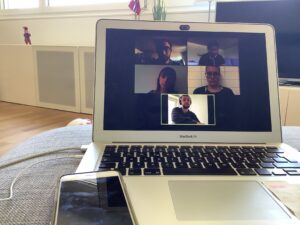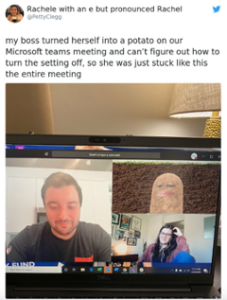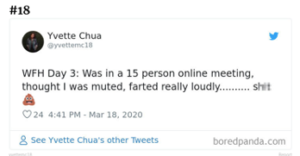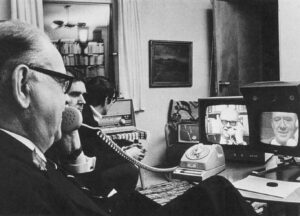Is this a wake-up call? Or are we allowing a new level of surveillance into our lives?
Reflecting on a week on and around Zoom

Everyday group meeting on Zoom captioned in a photo
As this week comes to an end, we can start to reflect on the challenges this virtual Summer School has posed on us. Still digesting the digital “bombardment” that guided our paths this week, we conclude that it was both a very challenging but also very fascinating process to work with and via the technology that dictates our every move - Zoom.
Starting from different approaches and perspectives on how digital technologies such as headphones, the television, Microsoft Teams, and Zoom effects our lives, we together embarked on a common journey to answer the question: how does the digital technology Zoom, changes the way we organize and the way we are organized in the current pandemic?
Digiphrenia (Rushkoff) partly hit us already after the first day’s lectures. Quickly we realized that we had to take responsibility to work hard to both process the information consumed through Zoom, and to work with the digital entanglement of Zoom. Using different academic methods and personal reflections, we tried to tear Zoom into pieces to put together a holistic picture. We were not aware of how hard it would be to constantly work with the medium that is in front of our faces, and through which we perceive each other every day from morning to evening. Following a contextual analysis of the technological, historical, and societal perspective, we tried to grasp the power of Zoom as a third party. Leaving us isolated, and without the luxury of normal human interaction, the technology poses an immense influential power onto our interactions, and the ability to build relationships. How did we come to accept this new normal in which the digital room of Zoom is not just a lecture but also the same classroom where you talk with your professors, you also meet your parents, talk gossip with your friends, go to the toilet, or date someone? And how could we break free and question this new normality? Then on Wednesday evening we experienced a breakthrough: with the “dancing class” we saw what was possible when we completely stepped out of the normal usage patterns exhibited on Zoom. Through this challenging task and the reinforcing workshop with Simon Denny, we were able to come up with the overall idea that we wanted to transport through our presentation:
We want to take students on a journey through this "new normal" and show them how much this deviates from our normal life and which affects not only the individual but also society can be observed.
The journey brought us to conclude six important aspects about Zoom that we want to explain and dissect to give a grasp of Zoom’s influence on our new normality:
Move away from the original purpose:
Zoom was intended to be a video-conferencing tool for the workplace. To replace in-person meetings and reduce traveling.
Change in Communication:
We are not able to use and understand body language, miss “heated” creative discussions and are finally left less satisfied with the outcomes.
Relationship Impact:
Personal relationships on an individual, spontaneous basis are less easy to form because we lack normal interaction (e.g. eating together).
Emotional Impact:
We feel anxious, lonely and little satisfied with what we do. For more check out this video one of our group members made: My emotions on Zoom
Third-party Relation:
Suddenly, even without being consciously perceived by us, there is a third-party player within our communication.
Power Play & Control:
While some artifacts of power are taken away (e.g. the corner office), overall there is a bigger bureaucracy with the scheduling and hosting of meetings. One host is in control of the others and can manage their reactions, while everybody can easily take videos or photos of the screen without the others knowledge.
The Corona crisis has thrown humankind in general, and we as students and professors into a temporary crisis – we are still not in a virtual classroom; we are actually in front of our screen looking and calling into the void. But this also offers a unique opportunity: either we can see this as a moment of realization and change, or the moment of accepting a new level of surveillance in our lives. Having had the opportunity to dive into the socio-technological entanglement of Zoom as part of our everyday life, we believe that we need more rules and adaptions in our use of Zoom and much more research on its impact and relevance. Thus, we want to call out to you! Wake up, reflect on your experience, and make a difference.
Thank you for reading. Thank you for the memories, your valuable insights, and the effort every one of you put into this week!
We know how tiring this week has been, so enjoy your long weekend, go out, meet people (if possible) and enjoy an Aperó. And always remember... even on Zoom, don’t be evil ;-)
Love,
Alma, Bea, Davide, Karolina & Oskar
(For some lasting memory of Alma: Weird glitches on Zoom)
PS: For more information check out this collection of articles.
- On Zoom, and its impact in the current crisis:
- On the world after COVID-19:
- Some Zoom "glitches":
- The straining effects of Zoom:
- How to handle Zoom fatigue:
Understanding the “new normal” – Don’t be evil!
How Zoom controls our lives and how we can gain back control
Since the coronavirus hit Europe, we have been taken on a journey to a “new normal”. A mode that is supposedly normal but consists of several abnormalities, if you put it in an extreme way. The space in which we normally act has been removed, and our everyday actions are now transferred into our personal spaces by the help of an important third party: Zoom. We now gather for a wide range of activities – both private and professional – without being physically present. Stripped of our normal routines, we unconsciously were thrown into a new normal, without reflecting and challenging this peculiar situation which has been forced upon us. May it be that we more often than not find ourselves walking around in pajama pants in class, being exposed on the Zoom stage when picking our noses or dancing with our professors on Zoom into the late evening.
Entering the stage of Zoom for the fourth, intensive day in a row, our group was somewhat drained but also excited to learn more about how we as individuals can start to understand the current situation, which is centered around an extensive use of man-made technology. How can we start to understand and reflect on a technology that is so close we might not even realize it? How do humans and technology interact to form the experience we currently make?
One interesting opportunity to estrange us from our current (over-)use of Zoom, and the unconscious rules and set of behavior we exhibit, was given to us last night. Dancing with our teachers, showing our armpits and private spaces – these experiences naturally caused some upstir in our class. While some participants experienced the event as deeply unpleasant or even manipulating, others embraced it with great joy. Internally in our small group we came to a common consensus that the event had been somewhat intimidating and uncomfortable to most of us. One important aspect of that was the recording of our dance in the end. Another one was the fact that this was somewhat mandatory, both for extroverts and introverts – just think about it, if we were in Berlin, we could have decided to join a party in the evening, thus having control over who sees us in what condition. Now we did not have this choice. Of course, one could exclude herself from the evening program – but then where is the sense of community on the other hand?
Intellectually today was a day of great learnings. The lecture and following discussions with Simon Denny were a real blast and boosted both our predisposition and creativity. As a real master of his language, he managed to get his message along, even when deprived of visual cues of communication. Interacting with the group through storytelling, video clips, and pictures, he managed to explain fairly complex themes, across many layers of society. With a pen in the hand and minds suddenly lightening up, our group enjoyed a great discussion.
Early into our discussion, one of our group members asked Simon: What is the material footprint related to Zoom? The following discussion would last, non-stop, the whole session. You see, there may be many “hidden” materialistic effects of the use of Zoom on for instance the environment, in particular concerning the energy infrastructure. The interesting thing about video conferencing is that it is not virtual, it is actual. And with actual implication on energy usage, that might be larger than you think!
Also, did you know that the internet has its origins in military tools for surveillance? Or that the servers through which it operates are subject to the law in the country in which it is stationed? In other words, by using Zoom we trust commercial systems with our everyday (private live). And enable them to keep the world under some sort of surveillance. In our group this discussion raised a particularly interesting discussion: Is the COVID-19 situation making us more aware of the dangers and possibility of such systems, thus being way a "wake-up" call with regards to the power of such technologies? Or is the COVID-19 situation the great moment of acceptance/naturalization, where we accept a new level of surveillance into our lives?
While we are no fortunetellers, there are some great opinion pieces out there to reflect on these questions. For example, check out this article by Israeli historian Yuval Harari: https://www.ft.com/content/19d90308-6858-11ea-a3c9-1fe6fedcca75.
Getting closer to the end of what has been an exhausting yet very enlightening week, we are getting closer to a more wholistic perspective on Zoom videoconferencing. With inputs from a historian, a sociologist, our professors, our class (!), several artists and many more other scholars, we were able to gather new important insights into how to approach and understand Zoom. And finally, an approach to improve our current situation for good? While we don't have an agency to control Zoom, we may push back, we may uncover its vulnerabilities, and we may transfer our understanding of the tool and how it changes what is perceived as normal and abnormal, to you – our peers. So that we can all walk away after this week, with knowledge and tools ready to encounter an even more digitalized normality.
We are looking forward to uncovering the mix of technologies that this current crisis has brought into our lives with you tomorrow!
Xoxo,
The Zoom-bombers – Alma, Bea, Davide, Karolina & Oskar


Screenshots of abnormal things that have happened via Zoom – because life is better when you laugh ;)
Communicating in times of COVID-19
How Zoom videoconferencing has ventured its way into our life… and is here to stay? Lessons from history.
Coming together as international, interdisciplinary students from four countries, we are going to get on a cultural journey looking at and assessing the effects of a technology or media. During the preparation of this summer school, all members of our group chose one technology that they were interested in and analyzed it from different perspectives of interest. Drawing on these technologies, we came together as a group with a basic understanding of socio-technological entanglements, heightened through the current pandemic. But how were we able to talk to each other face-to-face when the borders of the countries we reside in are still closed? Well, our lecturers chose Zoom videoconferencing as the way to go.
Interestingly, our group entailed different but still very similar technologies. Among these were earphones (especially noise-canceling earphones), the TV, Microsoft Teams and... Zoom. Without even realizing it, we started to talk about Zoom and how we feel about using it day in and out for our lectures, our private life, or our work. While Zoom enables us to hold this Summer School even though we are in the middle of a global pandemic, there were also several factors that our team members felt discomforted with. For example, Zoom strains our battery – not only the battery of our phones but also our own "battery". Moreover, we lose the ability to focus on a lecture, missing “real” interaction.
Being a part of a network, only possible to use with internet access and a personal device to log in with, Zoom is only one application of a bigger network of communication technologies. Inspired by a lecture from Prof. Dr. Claus Pias, we started to think about the historical development of such communication tools. Did you know that the radio, the TV, and the telephone were all developed within 20 years during the late 18th century? Well we certainly were not aware of this. The basic idea for videoconferencing was only developed slightly later during the 1930s when the telephone became widely popular and accessible. But what drove those developments? Why did Mr. Bell see the need to develop the telephone? And why did somebody want to develop an alternative for telephony by inventing videoconferencing? Well we think that such technological developments were always driven by societal development – for example the great immigration waves from Europe to the US. Back then, people were searching for vicinity and proximity to their loved ones, looking for a feeling of home and comfort, for example the voice of your relatives or pictures of their home country. Throughout history, these technologies have changed their purpose continuously. The underlying technology was constantly developed, only the terminology used to describe it remained unchanged – think about the several artefacts all referred to as a phone.

Swedish Prime Minister Tage Erlander using an Ericsson videophone to speak with Lennart Hyland, a popular TV show host (1969). Image via method shop
Zoom as one of the most popular solutions for videoconferencing was originally developed as a conferencing tool for companies. As an add-on to normal telephone conferences, companies were enabled to hold face-to-face meetings with members from all over the world. Face-to-face communication produced a feeling of personal proximity and community.
Nowadays though Zoom is used for several private and work-related meetings. Different than our ancestors adopting the telephone, we were forced to adapt Zoom within days. Driven by the global rise of the COVID-19 pandemic, most companies and universities quickly transferred to the video-conferencing platform. Leaving users with no time to adjust, an interesting effect could be observed: People started to compare Zoom to other communication tools and were dissatisfied with the “new normal”. Suddenly people craved for “social noise” such as a loud street or cafeteria. This effect is also known as the historical narrative of loss.
So, let us take a step back. Before trying to analyze and judge the technology of Zoom, we want to try to understand it better from a technological, historical, and societal perspective. Oftentimes, politicians and innovators believe that the investment in technology will solve all related issues (as we can also see with the current search for a vaccine for the Sars-Cov-2 virus). However, this ignores the drivers of the development of new technology. Because in the end a technology (at the moment) does not develop itself, it does not “know” how to improve or change if not for a smart coder or technician. Thus, this week, we want to take a holistic perspective on the technology of Zoom, how we as individuals perceive it, feel about it, and think about it.
"See you" tomorrow!
Alma, Bea, Davide, Karolina & Oskar